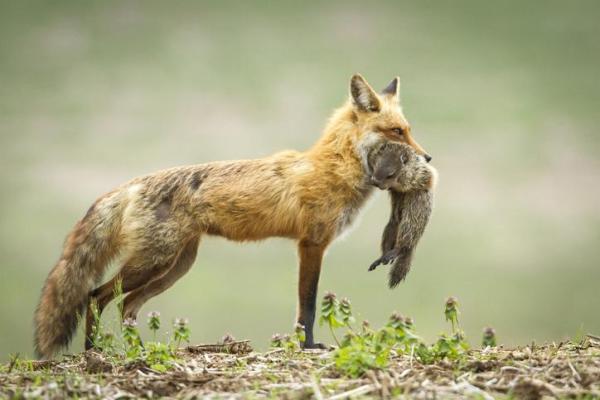
Trophic levels are analyzed and studied under the discipline of ecology, a subset of biology. This is the science which studies the relationships established between an environment and the organisms within it. This includes the relationships and interactions the species within these environments have with each other.
One of the most important relationships organisms have with each other is to do with nutrition. This has to do with how organisms feed on other organisms for sustenance. This allows them to carry out necessary activities and expend various levels of energy. This will give you a basic clue as to what are trophic levels. Let AnimalWised explain further.
What is a terrestrial food chain?
In ecology, food chains refer to the transfer energy and matter which passes from one organism to another. Additionally, they take into account the energy which is lost in each group of organisms. This energy is lost through various processes such as respiration. Terrestrial food chains are those which are concerned with this transfer of energy in terrestrial animals. This means plant and animal species which carry out their vital functions on land, not aquatic environments.
A trophic level is the level at which a given organism resides on a food chain. The trophic level of one organism depends on how it relates to other organisms within the same food chain. Within a terrestrial food chain, we can find:
- Producer organisms: individuals, usually plants, that transform inorganic matter into organic matter. They are the beings that initiate the chain.
- Primary consumers: these are the animals that feed on the whole producing organisms or some of their parts. These parts may include leaves, roots, seeds or fruits. In general, they are herbivorous animals, although omnivorous animals also eat plants.
- Secondary consumers or mesopredators: they are predatory animals that hunt and feed on the primary consumers or herbivores. Therefore, they are carnivorous animals.
- Tertiary or super-predatory consumers: these animals can feed on both herbivores and primary consumers. They are essential in ecosystems since, in many cases, they act as "umbrella" species. These are organisms which act to maintain the balance within an given ecosystem. Humans do this consciously, but the innate behavior of many animals acts as a protector species.
In ecosystems there are no simple trophic chains where we find an individual at each level. It is a complicated system of interactions where many chains are related to each other in various manners. This is why the trophic chains links together to from what is known as a "trophic network".
Difference between terrestrial and aquatic trophic chain
Each ecosystem has its own trophic levels, formed by the animals and plants which live in a given biome. A trophic chain of a terrestrial ecosystem differs from an aquatic trophic chain in that the second is formed by beings that inhabit aquatic environments. The former, as we have said, are those which live on land.
Occasionally, aquatic and terrestrial food chains can link to the same trophic network. This means aquatic organisms may feed on terrestrial ones and vice versa. For example, the common kingfisher (Alcedo atthis), which is part of the terrestrial food chain, also feeds on small fish which live in an aquatic environment. An example of the opposite would be the archerfish (Toxotes sp.), an aquatic animal which consumes insects which fly over the water or land on vegetation surrounding it.

Example of terrestrial trophic levels
The number of examples of trophic levels in terrestrial food chains (or, more precisely, food webs) are practically countless. In addition, new relationships are discovered almost daily as studies in different ecologies develop. Next, we show you two examples of terrestrial trophic levels interaction in a food chain:
Example 1
Pot marigold (Calendula officinalis) > European honey bee (Apis mellifera) > European bee-eater (Merops apiaster) > Red fox (Vulpes vulpes)
In this example of trophic levels in a terrestrial food chain, the marigold is the producing organism. The bee only feeds on the pollen and nectar of the flower. The bee-eater is a bird specialized in hunting bees, although other insects can also become prey for them. Finally, the red fox, although it does not hunt adult specimens, attacks the nests that these birds build on the ground, preying on the eggs to eat hatchlings as sustenance.
Example 2
Sitka spruce (Picea sitchensis) > Alaska moose (Alces alces gigas) > Arctic fox (Vulpes lagopus) > Gray wolf (Canis lupus)
The Sitka spruce is a conifer with seed cones which serve as food for Alaska moose. This is not directly hunted by the Arctic fox, but they are known to scavenge for carrion (i.e. they eat the remains of a deceased moose). The gray wolf is a super predator that habitually predates on both elk and Arctic foxes.

If you want to read similar articles to What are Trophic Levels?, we recommend you visit our Facts about the animal kingdom category.
- Bitetti, D., & Santiago, M. (2008). Top Predators and Trophic Cascades in Terrestrial Environments. Biological Conservation, 142:11. 2401-2414.
https://www.sciencedirect.com/science/article/abs/pii/S0006320709002584 - Muller, C. E., et al. (2011). Bioaccumulation of Perfluorinated Compounds in A Remote Terrestrial Food Chain: Lichen-Caribou-Wolf. Environmental Science & Technology, 45:20, 8665-8673.
https://pubs.acs.org/doi/10.1021/es201353v - Odum, EP (1974). Ecology.